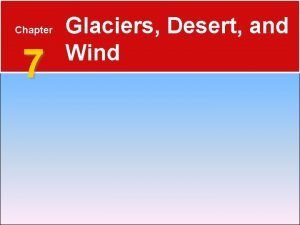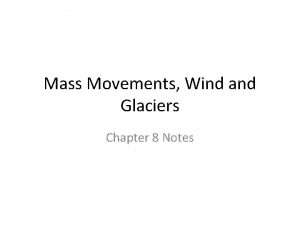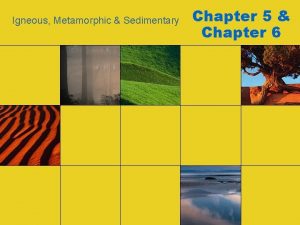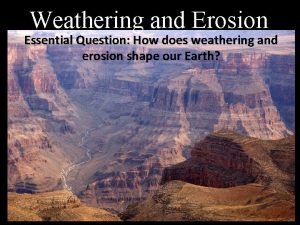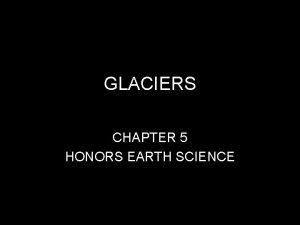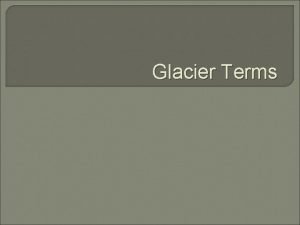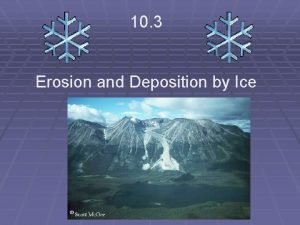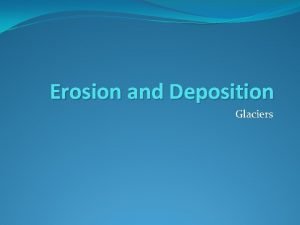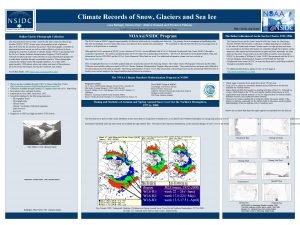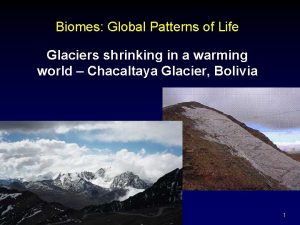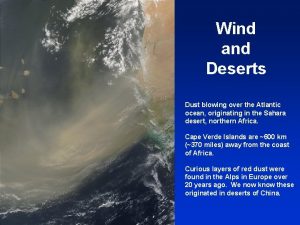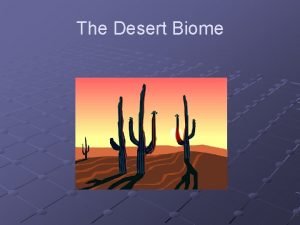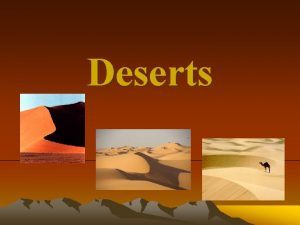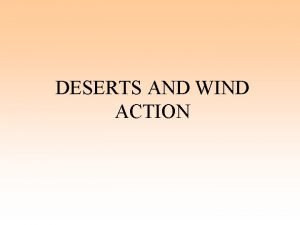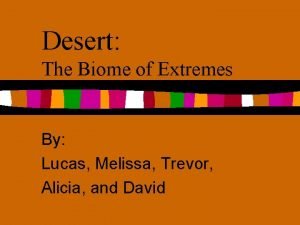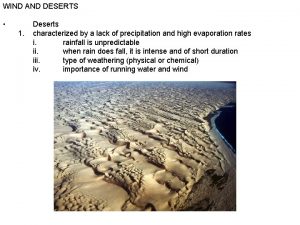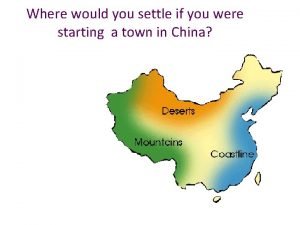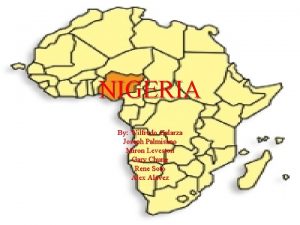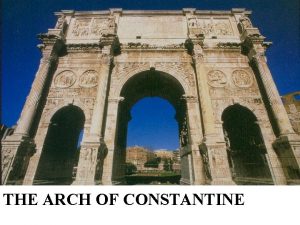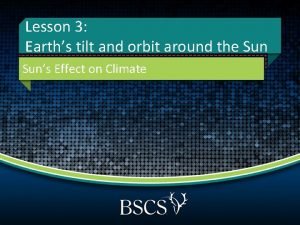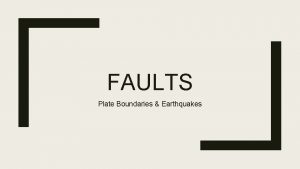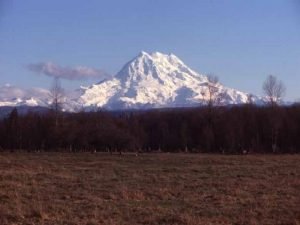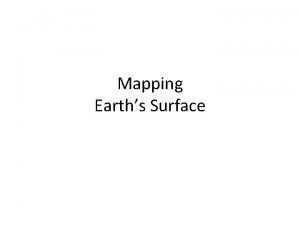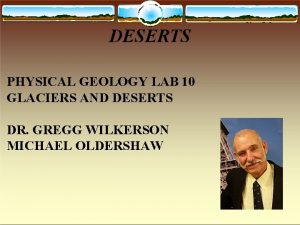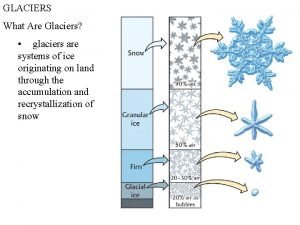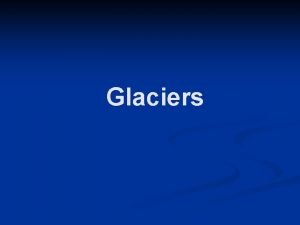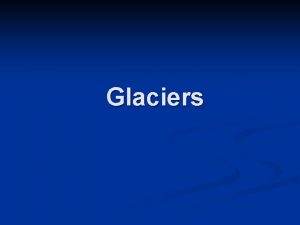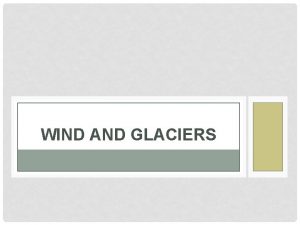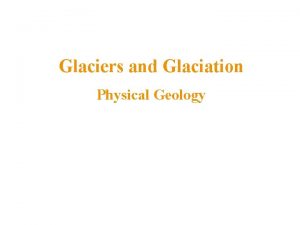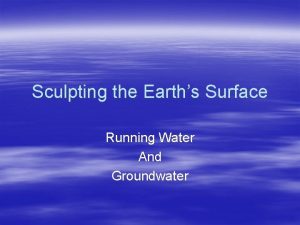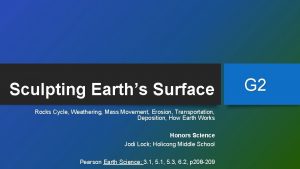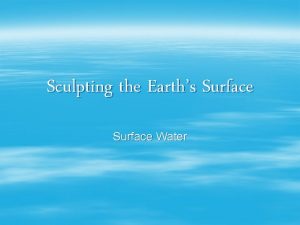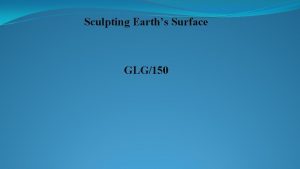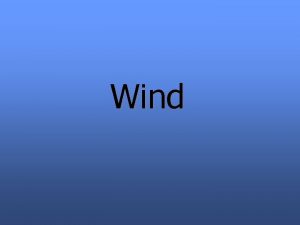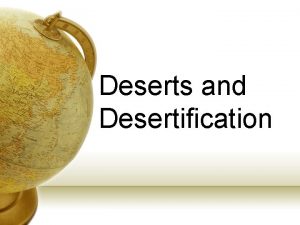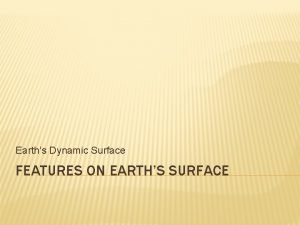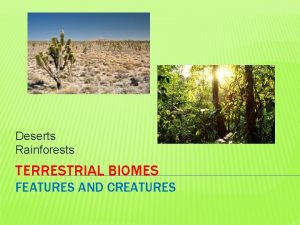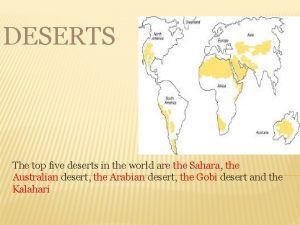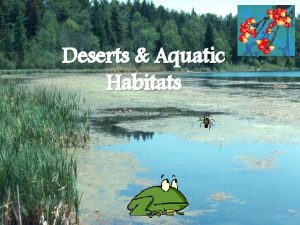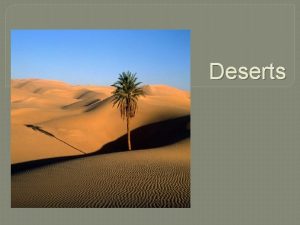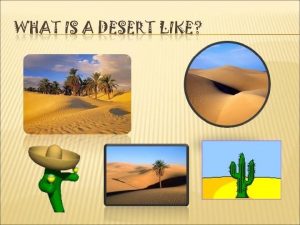Sculpting the Earths Surface Glaciers Deserts and Wind























































- Slides: 55

Sculpting the Earth’s Surface Glaciers, Deserts, and Wind

Glaciers • Glaciers are a part of both the hydrologic cycle and rock cycle • A thick mass of ice that originates on land from the accumulation, compaction, and recrystallization of snow

Glaciers • Location – Occupy 10% of Earth’s surface • Primarily located in polar regions (Antarctica & Greenland) • But found on every continent – Form above the snow line

Glaciers • Formation – New layers form each year – Weigh of overlying layers compresses buried layers • Snow recrystallizes – looks like sugar • Snow begins to grow, air pockets decrease • compacts & becomes very dense • After 2 winters => FIRN

Glaciers • Formation (continued) – Firn • Generally 16 x the size of a snow crystal • ½ as dense as water • Increase in size as the overburden increases • Over time, grows to form even larger crystals • Forms glacial ice

Glaciers • Movement – When ice sheet thickness > 18 meters, the ice sheet: • Deforms • Flows – Movement slower at base than at top – Advance and retreat – Surge

Glaciers • Types of glacial movements – Plastic flow – Basal slip

Glaciers • Rates of movement – Average velocities vary considerably – Rates of up to several meters per day – Some glaciers exhibit extremely rapid movements called surges

Glaciers • Movement (continued) – Budget of a glacier • Accumulation + loss = glacial budget

If accumulation exceeds loss (called ablation), the glacial front advances

If ablation increases and/or accumulation decreases, the ice front will retreat

Glaciers Features – Crevasses – Moraines Barnard Glacier http: //nsidc. org/glaciers/questions/compo nents. html


Glaciers Types – Ice • • • Ice Sheets, Ice Shelves, Ice Caps, Ice Streams, and Ice fields – Glaciers • • • Mountain Glaciers, Valley Glaciers, Piedmont Glaciers, Cirque Glaciers, Hanging Glaciers, Tidewater Glaciers.

Types of Glaciers

Glaciers • Glaciers erode by – Plucking – lifting of rock blocks – Abrasion • Rock flour (pulverized rock) • Striations (grooves in the bedrock)


Glaciers • Glacial deposits – Glacial drift • All sediments of glacial origin • Types of glacial drift – Till – material that is deposited directly by ice – Stratified drift - sediment deposited by meltwater

Glaciers • Glacial deposits – Depositional features • Moraines – layers or ridges of till • Types of moraines – – Lateral Medial End Ground

Glaciers • Glacial deposits – Depositional features • Outwash plain, or valley train • Kettles • Drumlins • Eskers • Kames

Glacial depositional features

Glaciers • Ice Ages – Have occurred throughout Earth’s history

Glaciers • Ice Age – Began 2 to 3 million years ago – Division of geological time is called the Pleistocene epoch – Ice covered 30% of Earth's land area

Glaciers • Indirect effects of Ice Age glaciers – Migration of animals and plants – Rebounding upward of the crust – Worldwide change in sea level – Climatic changes


Glaciers • Causes of glaciation – Successful theory must account for • Cooling of Earth, as well as • Short-term climatic changes

Glaciers • Causes of glaciation – Proposed possible causes • Plate tectonics – Continents were arranged differently – Changes in oceanic circulation (Thermohaline Current)

Glaciers • Causes of glaciation – Proposed possible causes • Variations in Earth's orbit – The Milankovitch hypothesis » Shape (eccentricity) of Earth’s orbit varies » Angle of Earth’s axis (obliquity) changes » Earth’s axis wobbles (precession)

Desert • Definition : – A region so arid that it contains no permanent streams except for those that bring water in from elsewhere, and has very sparse vegetation cover. – NOT related to temperature! – Deserts can be • Hot (>35 °C) • Cold (< 20 °C)

Desert • Location – Dry regions cover 30% of Earth’s land surface

Desert • Types of deserts – Two climatic types are commonly recognized • Desert or arid • Steppe or semiarid

Deserts • Types of deserts – Classified by environment in which they are formed • subtropical: in the hot dry latitudes between 20 and 30°, both north and south • rain shadow: on the landward side of coastal mountain ranges • coastal: along coasts bordering cold ocean currents • continental interior: deep within continents, far from major water sources • polar: in the cold dry polar regions, both north and south

Location of Deserts

Earth’s dry regions coincide with the subtropical high pressure belts & solar heating

Deserts • Weathering and Erosion – Not as effective as in humid regions – Mechanical weathering forms unaltered rock and mineral fragments – Some chemical weathering does occur • Clay forms • Thin soil forms

Deserts • Weathering and Erosion – Water Erosion • Desert rainfall – Rain often occurs as heavy showers – Causes flash floods • Poorly integrated drainage • Most erosional work in a desert is done by running water


Deserts • Weathering and Erosion – Water Erosion • Streams are dry most of the time • Desert streams are said to be ephemeral – Flow only during periods of rainfall – Different names are used for desert streams including wash, arroyo, wadi, donga, and nullah

A dry stream channel in the desert

The same stream channel following heavy rainfall

Deserts • Weathering & Erosion – Wind erosion • Differs from that of running water in two ways – Wind is less capable of picking up and transporting coarse materials – Wind is not confined to channels and can spread sediment over large areas

Deserts • Weathering & Erosion – Wind erosion • Mechanisms of transport – Bedload » Saltation – skipping and bouncing along the surface – Suspended load » In the air as duststorms

Deserts • Weathering & Erosion – Wind erosion • Mechanisms of wind erosion – Deflation » Lifting of loose material » Produces Blowouts & Desert pavement

Deserts • Weathering & Erosion – Wind erosion • Mechanisms of wind erosion – Abrasion » Produces ventifacts (stones with flat faces) and yardangs (wind sculpted ridges) » Limited in vertical extent

Deserts • Depositional Environments – Water Deposits • • Talus Aprons Alluvial Fans Bajada Playas and Salt Lakes

Deserts • Depositional Environments – Wind deposits • Dunes – Mounds or ridges of sand – Often asymmetrically shaped – Characteristic features » Slip face » Cross beds

Types of Sand Dunes

Deserts • Depositional Environments – Wind deposits • Loess – Deposits of windblown silt – Extensive blanket deposits – Primary sources are deserts and glacial stratified drift

Deserts • Basin and Range: the evolution of a desert landscape – Uplifted crustal blocks – Interior drainage into basins produces • Alluvial fans and bajadas • Playas and playa lakes

Deserts • Basin and Range: the evolution of a desert landscape – Erosion of mountain mass causes local relief to continually diminish – Eventually mountains are reduced to a few large bedrock knobs called inselbergs projecting above a sediment filled basin

Landscape evolution in a mountainous desert – early stage

Landscape evolution in a mountainous desert – middle stage

Landscape evolution in a mountainous desert – late stage

Inselbergs in Southern California

~ End ~
 Chapter 7 glaciers deserts and wind
Chapter 7 glaciers deserts and wind Examples of mass movement
Examples of mass movement Angular sedimentary rocks
Angular sedimentary rocks Glaciers cause erosion by abrasion and
Glaciers cause erosion by abrasion and Chapter 5 glaciers oceans and landscapes
Chapter 5 glaciers oceans and landscapes What is subtractive sculpture
What is subtractive sculpture Dscr project finance
Dscr project finance Describe the draping procedure for a shampooing service
Describe the draping procedure for a shampooing service Minnesota glaciers map
Minnesota glaciers map Alpine glacier vs continental glacier
Alpine glacier vs continental glacier How can a glacier deposit both sorted and unsorted material
How can a glacier deposit both sorted and unsorted material Terminal moraines
Terminal moraines Nsidc glaciers
Nsidc glaciers Bolivia glaciers
Bolivia glaciers Kurshalter
Kurshalter What causes wind to blow
What causes wind to blow Rap video in desert
Rap video in desert Desert biome location
Desert biome location Food deserts in minnesota
Food deserts in minnesota Two types of desert
Two types of desert What is wind action
What is wind action What causes deserts
What causes deserts Characteristics of deserts
Characteristics of deserts Ancient china on a map
Ancient china on a map Fertile
Fertile Deserts
Deserts Rain shadow deserts
Rain shadow deserts Great wall of california
Great wall of california What are deserts
What are deserts Nigerian deserts
Nigerian deserts The earth's layers foldable
The earth's layers foldable Earths roation
Earths roation Whats a natural satellite
Whats a natural satellite What makes one biome different from another?
What makes one biome different from another? Periodic table of elements families
Periodic table of elements families Plasticity in earth's layers
Plasticity in earth's layers Whats earths moon called
Whats earths moon called Thickest layer of the earth
Thickest layer of the earth Earths early atmosphere contained
Earths early atmosphere contained Earth's layer foldable
Earth's layer foldable Earths major crustal plates
Earths major crustal plates Earths orbit seasons
Earths orbit seasons Brown earth soil ireland
Brown earth soil ireland Study of earth's physical features
Study of earth's physical features Earth's honey fertilizer
Earth's honey fertilizer What is luna moon
What is luna moon Earths mantle
Earths mantle Earths crust
Earths crust Where
Where What does the earths tilt cause
What does the earths tilt cause Atmosphere
Atmosphere What shape is earths orbit
What shape is earths orbit Arch of constantine frieze
Arch of constantine frieze What does earths tilt do
What does earths tilt do Earths boundaries
Earths boundaries Earths 4 spheres
Earths 4 spheres
